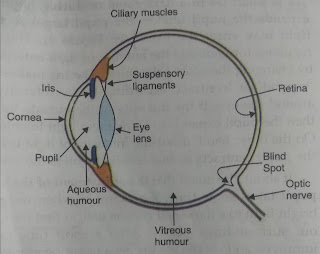Our eye is the most important organ gifted to us by god. Eye is a delicate organ which once destroyed cannot be cured. It helps us to see the beautiful and bright world around us. But ever wondered how the eye works? What are the tissues and cells that makes up an eye?
The first thing to know is that, the main parts of eyes are- Cornea, Iris, Ciliary Muscles, Eye lens, Retina and Optic Nerve. It is spherical in shape with a diameter of 2.3cm
CONSTRUCTION OF EYES
- The front part of the eye is called cornea. It is made up of a transparent substance and it bulges outwards. The light coming from the objects enters the eyes through cornea.
- Behind the cornea is the iris. Iris is a flat, coloured, ring-shaped membrane behind the cornea of the eye.
- There is a hole in the middle of the iris which is called Pupil of the eye. Thus, we can say thet pupil is a hole in the middle of the iris. The pupil appears BLACK because no light is reflected from it.
- Then comes the eye lens. It is a convex lens made up of a transparent, soft and flexible material like a jelly made of protiens. The eye lens can change its shape because of its flexible nature to focus light on to the retina.
- The eye lens is held in its position by suspensory ligaments. One end of suspensory ligaments is attached to the eye lens and the other is attached to the ciliary muscles.
- Ciliary muscles is very important for the functioning of eyes because it helps to change the thickness of eye lens while focusing. In other words, ciliary muscles helps in changing the focal length of the eye lens which in turn help eyes to look far as well as nearby objects clearly.
- There is a screen at the back of the eye on which the image is formed, it is called retina.
- An optic nerve is attached to the retina that sends the image formed to the brain through electrical signals.

WORKING OF THE EYE
The below points will explain how the eye works and what different tissues do.
- The light rays coming from a light source or reflected by an object enters our eye through CORNEA(convex shape). It is the cornea that converges most of the light( to display the image on retina).
- The light then passes through the pupil of the eye and then fall on the eye lens. Being convex in shape, eye lens converges the light rays and produces a real and inverted image of the image on retina.
NOTE- Cornea converges most of the light rays, only a final convergence is given by the eye lens to focus the image on the retina.
- The image formed on the retina is conveyed to the brain by the optic nerve and gives rise to the sensation of vision.
- Actually, when the light falls on the retina, many light sensitive cells activates and generate electric signals. The retina sends these signals to the brain via optic nerve and give rise to the sensation of vision..
- Although the image formed on retina is inverted, brain interprets it as that of an erect object and then we are able to see objects around us.
HOPE IT HELPS
THANK YOU😀


Thank you! For this
ReplyDeleteVery useful
Cool and I have a neat offer you: Where To Buy Houses For Renovation home bathroom remodel
ReplyDelete